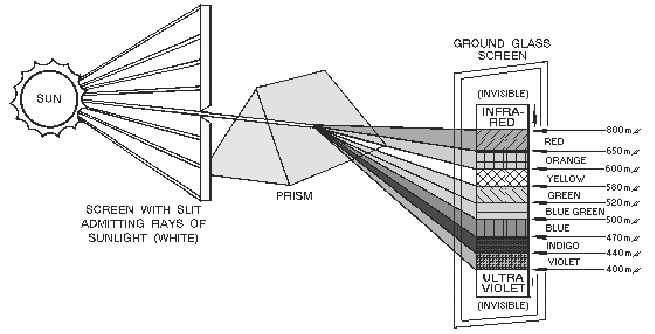1-27
FREQUENCIES AND WAVELENGTHS
Compared to sound waves, the frequency of light waves is very high and the wavelength is very
short. To measure these wavelengths more conveniently, a special unit of measure called an
ANGSTROM UNIT, or more usually, an ANGSTROM (
ZDV GHYLVHG $QRWKHU FRPPRQ XQLW XVHG WR
measure these waves is the millimicron (P ZKLFK LV RQH PLOOLRQWK RI D PLOOLPHWHU 2QH P) HTXDOV WHQ
angstroms. One angstrom equals 1055-10m.
Q33. What unit is used to measure the different wavelengths of light?
FREQUENCIES AND COLOR
For our discussion of light wave waves, we will use the millimicron measurement. The wavelength
of a light determines the color of the light. Figure 1-18 indicates that light with a wavelength of 700
millimicrons is red, and that light with a wavelength of 500 millimicrons is blue-green. This illustration
shows approximate wavelengths of the different colors in the visible spectrum. In actual fact, the color of
light depends on its frequency, not its wavelength. However, light is measured in wavelengths.
Figure 1-18.—Use of a prism to split white light into different colors.
When the wavelength of 700 millimicrons is measured in a medium such as air, it produces the color
red, but the same wave measured in a different medium will have a different wavelength. When red light
which has been traveling in air enters glass, it loses speed. Its wavelength becomes shorter or compressed,
but it continues to be red. This illustrates that the color of light depends on frequency and not on
wavelength. The color scale in figure 1-18 is based on the wavelengths in air.
When a beam of white light (sunlight) is passed through a PRISM, as shown in figure 1-18, it is
refracted and dispersed (the phenomenon is known as DISPERSION) into its component wavelengths.
Each of these wavelengths causes a different reaction of the eye, which sees the various colors that
compose the visible spectrum. The visible spectrum is recorded as a mixture of red, orange, yellow,
green, blue, indigo, and violet. White light results when the PRIMARIES (red, green, and blue) are mixed



